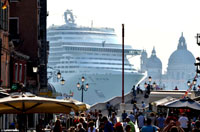
MSC Divina dwarfs the historic domes of Venice Photo: Splash News
MSC’s newest passenger ship, the MSC Davina, recently called at the Venice lagoon setting off a storm of protests. The protesters think that such a large ship creates too much pollution and could damage the fragile environment of the lagoon.
The MSC Davina is 139,400 GT, almost 1,100 feet long, about 125 feet wide and carries up to 5,329 passengers and crew, or about 40,000 GT and almost 500 passengers larger than the Costa Concordia.
The MSC Davina was christened at the end of last month by the Italian actress Sophia Loren. No doubt, in hopes of garnering publicity, the “No Big Ships Venice Committee” has written an open letter to Ms. Loren asking her to revoke any endorsement of the ship. Thus far there has been no response from the Italian actress.
Monster ship that’s the menace of Venice: Furious protesters call for ban on huge cruise liner which carries 4,500 people
While the recent news coverage has largely focused on the arrival of a single ship, the MSC Davina, this is only the continuation of a much longer protest lead by Italia Nostra (Our Italy), a conservation group, over the size of cruise ships that are allowed to call in Venice. Italia Nostra is calling for a limit of 30,000 GT for passengers ships in the Venice lagoon.
The growth in the Venetian cruise trade has been dramatic. Venice is one of the most popular cruise ports in Southern Europe, and it’s tied with Rome’s Civitavecchia as the busiest port in Italy. More than 600 cruise ships call each year. As reported by the New York Times, “In 1999, fewer than 100,000 people visited Venice as part of a cruise, while last year nearly 1.6 million did.” Cruise passengers this year are expected to top 1.8 million.
Taking a quick look at the ships that already call in Venice, it is clear that while the MSC Davina is the largest, it is not so by much. The Costa Favolosa is the same size and class as the ill-fated Costa Concordia. The Ruby Princess and the Crown Princess are also roughly the same size as the Costa Concordia. The Norwegian Jade at 93,000 GT is also a very large ship, as are the MSC Musica, the Grandeur of the Seas, the Crystal Serenity, Splendour of the Seas, and the MSC Armonia, all of which range from close to 60,000 to almost 80,000 GT. Ships of this size would be banned from the lagoon under the proposal by Italia Nostra.
Venice is now faced with the challenge of managing the volume of cruise tourism while not damaging the heritage or ecology of the historic city. Clearly, not an easy balance to strike.
Thanks to Alaric Bond and Phil Leon for contributing to the post.

I sent this 3-days ago:
Venice environmentalists ask Sophia Loren to renounce ship
Reuters – By Philip Pullella | MILAN, Italy (Reuters) – Environmentalists on Saturday urged film diva Sophia Loren to help stop a big cruise ship named in her honour from ever entering the Venice lagoon because of potential damage to the city and the lagoon’s …
http://www.reuters.com/article/2012/06/04/uk-italy-venice-loren-idUSLNE85300K20120604
You did. I missed it. I’ve added you to the post.
While one would agree that these large vessels could do damage by water displacement to the lagoon buildings foundations it is absolute nonsense to quote pollution.
This seems to be a standard remark each time the radical environmentalists want to stop something. All garbage generated by the vessel is processed and held on board until a suitable disposal Port with proper facilities is reached. The engines have pollution control systems and strict regulations are in place to enforce clean exhaust from the funnels/stacks.
There is mostly likely more pollution generated by the glass making on Venice’s Murano Island than by this ship!! Lets get really sensable about pollution which is just as important to the cruise lines crews as it is to everyone else concerned about our environment – after all we make our living off a clean and attractive world for our passangers to enjoy.
Good Watch.
The issue of pollution is interesting. The most commonly quoted claim is that the ships produce more sulfur than x thousand cars, which is more or less true, as gasoline in recent years has been relatively lower in sulfur than residual fuels like Bunker C (which many cruise ships cannot use.) This misses the larger issue of pollution and the energy efficiency of ships. In several US cities there have been complaints about pollution from cruise ships at terminals which are immediately adjacent to major highways, where the pollution from trucks and cars has to be far greater than that from the exhaust of the cruise ships’ generators.